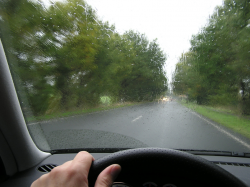
— Any driver will admit driving in rain takes more concentration and effort than driving on a clear blue day. Driving in rain at night is even more of a challenge, especially on the eyes.
But according to researchers at Carnegie Mellon University, the time is coming when driving at night in a rain storm will seem more like driving through drizzle.
Researchers at Carnegie Mellon University's Robotics Institute have invented a smart headlight system that can allegedly improve visibility by constantly redirecting light to shine between particles of precipitation, at least based on laboratory tests.
The system prevents the glare that occurs when headlight beams are reflected by precipitation back toward the driver.
"If you're driving in a thunderstorm, the smart headlights will make it seem like it's a drizzle," said Srinivasa Narasimhan, associate professor of robotics.
The system uses a camera to track the motion of raindrops and snowflakes and then applies a computer algorithm to predict where those particles will be just a few milliseconds later.
The light projection system then adjusts to deactivate light beams that would otherwise illuminate the particles in their predicted positions.
"A human eye will not be able to see that flicker of the headlights," Narasimhan said. "And because the precipitation particles aren't being illuminated, the driver won't see the rain or snow either."
In lab tests, researchers demonstrated their system could detect raindrops, predict their movement and adjust a light projector in 13 milliseconds.
At low speeds, such a system could eliminate 70 to 80 percent of visible rain during a heavy storm, while losing only 5 or 6 percent of the light from the headlight.
However, don’t expect to see the system installed on your next new-vehicle purchase.
To operate at highway speeds and to work effectively in snow and hail, the system's response will need to be reduced to just a few milliseconds, down from the current 13 milliseconds.
In addition, road-worthy systems likely would be based on LED sources, not cameras such as researchers used.
That could only happen if new LED technology allows.
"One good thing is that the system will not fail in a catastrophic way," Narasimhan said. "If it fails, it is just a normal headlight."




